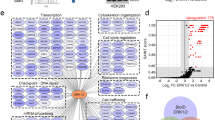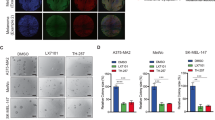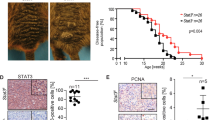Abstract
EphA2 is a member of the Eph family of receptor tyrosine kinases and is highly expressed in many aggressive cancer types, including melanoma. We recently showed that EphA2 is also upregulated by ultraviolet radiation and is able to induce apoptosis. These findings suggest that EphA2 may have different, even paradoxical, effects on viability depending on the cellular context and that EphA2 mediates a delicate balance between life and death of the cell. To functionally clarify EphA2's role in melanoma, we analyzed a panel of melanoma cell lines and found that EphA2 levels are elevated in a significant fraction of the samples. Specific depletion of EphA2 in high-expressing melanoma cells using short hairpin RNA led to profound reductions in cellular viability, colony formation and migration in vitro and a dramatic loss of tumorigenic potential in vivo. Stable introduction of EphA2 into low-expressing cell lines enhanced proliferation, colony formation and migration, further supporting its pro-malignant phenotype. Interestingly, transient expression of EphA2 and/or BrafV600E in non-transformed melanocytes led to significant and additive apoptosis. These results verify that EphA2 is an important oncogene and potentially a common source of ‘addiction’ for many melanoma cells. Moreover, acute induction of EphA2 may purge genetically susceptible cells, thereby uncovering a more aggressive population that is in fact dependent on the oncogene.
This is a preview of subscription content, access via your institution
Access options
Subscribe to this journal
Receive 50 print issues and online access
$259.00 per year
only $5.18 per issue
Buy this article
- Purchase on Springer Link
- Instant access to full article PDF
Prices may be subject to local taxes which are calculated during checkout





Similar content being viewed by others
References
Albini A, Iwamoto Y, Kleinman HK, Martin GR, Aaronson SA, Kozlowski JM et al. (1987). A rapid in vitro assay for quantitating the invasive potential of tumor cells. Cancer Res 47: 3239–3245.
Andres AC, Reid HH, Zurcher G, Blaschke RJ, Albrecht D, Ziemiecki A . (1994). Expression of two novel eph-related receptor protein tyrosine kinases in mammary gland development and carcinogenesis. Oncogene 9: 1461–1467.
Bogan C, Chen J, O'Sullivan MG, Cormier RT . (2009). Loss of EphA2 receptor tyrosine kinase reduces ApcMin7/+ tumorigenesis. Int J Cancer 124: 1366–1371.
Chen L, Park SM, Tumanov AV, Hau A, Sawada K, Feig C et al. (2010). CD95 promotes tumour growth. Nature 465: 492–496.
Connor RJ, Menzel P, Pasquale EB . (1998). Expression and tyrosine phosphorylation of Eph receptors suggest multiple mechanisms in patterning of the visual system. Dev Biol 193: 21–35.
Cui XD, Lee MJ, Yu GR, Kim IH, Yu HC, Song EY et al. (2010). EFNA1 ligand and its receptor EphA2: potential biomarkers for hepatocellular carcinoma. Int J Cancer 126: 940–949.
Debnath J, Muthuswamy SK, Brugge JS . (2003). Morphogenesis and oncogenesis of MCF-10A mammary epithelial acini grown in three-dimensional basement membrane cultures. Methods 30: 256–268.
Dohn M, Jiang J, Chen X . (2001). Receptor tyrosine kinase EphA2 is regulated by p53-family proteins and induces apoptosis. Oncogene 20: 6503–6515.
Easty DJ, Hill SP, Hsu MY, Fallowfield ME, Florenes VA, Herlyn M et al. (1999). Up-regulation of ephrin-A1 during melanoma progression. Int J Cancer 84: 494–501.
Ganju P, Shigemoto K, Brennan J, Entwistle A, Reith AD . (1994). The Eck receptor tyrosine kinase is implicated in pattern formation during gastrulation, hindbrain segmentation and limb development. Oncogene 9: 1613–1624.
Han L, Dong Z, Qiao Y, Kristensen GB, Holm R, Nesland JM et al. (2005). The clinical significance of EphA2 and Ephrin A-1 in epithelial ovarian carcinomas. Gynecol Oncol 99: 278–286.
Hendrix MJ, Seftor EA, Hess AR, Seftor RE . (2003). Molecular plasticity of human melanoma cells. Oncogene 22: 3070–3075.
Herath NI, Spanevello MD, Sabesan S, Newton T, Cummings M, Duffy S et al. (2006). Over-expression of Eph and ephrin genes in advanced ovarian cancer: ephrin gene expression correlates with shortened survival. BMC Cancer 6: 144.
Hess AR, Seftor EA, Gruman LM, Kinch MS, Seftor RE, Hendrix MJ . (2006). VE-cadherin regulates EphA2 in aggressive melanoma cells through a novel signaling pathway: implications for vasculogenic mimicry. Cancer Biol Ther 5: 228–233.
Hingorani SR, Jacobetz MA, Robertson GP, Herlyn M, Tuveson DA . (2003). Suppression of BRAF(V599E) in human melanoma abrogates transformation. Cancer Res 63: 5198–5202.
Kamat AA, Coffey D, Merritt WM, Nugent E, Urbauer D, Lin YG et al. (2009). EphA2 overexpression is associated with lack of hormone receptor expression and poor outcome in endometrial cancer. Cancer 115: 2684–2692.
Kataoka H, Igarashi H, Kanamori M, Ihara M, Wang JD, Wang YJ et al. (2004). Correlation of EPHA2 overexpression with high microvessel count in human primary colorectal cancer. Cancer Sci 95: 136–141.
Liang CC, Park AY, Guan JL . (2007). In vitro scratch assay: a convenient and inexpensive method for analysis of cell migration in vitro. Nat Protoc 2: 329–333.
Liu Y, Zhang X, Qiu Y, Huang D, Zhang S, Xie L et al. (2010). Clinical significance of EphA2 expression in squamous-cell carcinoma of the head and neck. J Cancer Res Clin Oncol 137: 761–769.
Lu C, Shahzad MM, Wang H, Landen CN, Kim SW, Allen J et al. (2008). EphA2 overexpression promotes ovarian cancer growth. Cancer Biol Ther 7: 1098–1103.
Margaryan NV, Strizzi L, Abbott DE, Seftor EA, Rao MS, Hendrix MJ et al. (2009). EphA2 as a promoter of melanoma tumorigenicity. Cancer Biol Ther 8: 279–288.
Menges CW, McCance DJ . (2008). Constitutive activation of the Raf-MAPK pathway causes negative feedback inhibition of Ras-PI3K-AKT and cellular arrest through the EphA2 receptor. Oncogene 27: 2934–2940.
Miao H, Li DQ, Mukherjee A, Guo H, Petty A, Cutter J et al. (2009). EphA2 mediates ligand-dependent inhibition and ligand-independent promotion of cell migration and invasion via a reciprocal regulatory loop with Akt. Cancer Cell 16: 9–20.
Miyazaki T, Kato H, Fukuchi M, Nakajima M, Kuwano H . (2003). EphA2 overexpression correlates with poor prognosis in esophageal squamous cell carcinoma. Int J Cancer 103: 657–663.
Moore-Scott BA, Opoka R, Lin SC, Kordich JJ, Wells JM . (2007). Identification of molecular markers that are expressed in discrete anterior–posterior domains of the endoderm from the gastrula stage to mid-gestation. Dev Dyn 236: 1997–2003.
Nemoto T, Ohashi K, Akashi T, Johnson JD, Hirokawa K . (1997). Overexpression of protein tyrosine kinases in human esophageal cancer. Pathobiology 65: 195–203.
Parri M, Taddei ML, Bianchini F, Calorini L, Chiarugi P . (2009). EphA2 reexpression prompts invasion of melanoma cells shifting from mesenchymal to amoeboid-like motility style. Cancer Res 69: 2072–2081.
Ruiz JC, Robertson EJ . (1994). The expression of the receptor-protein tyrosine kinase gene, eck, is highly restricted during early mouse development. Mech Dev 46: 87–100.
Seftor EA, Meltzer PS, Schatteman GC, Gruman LM, Hess AR, Kirschmann DA et al. (2002). Expression of multiple molecular phenotypes by aggressive melanoma tumor cells: role in vasculogenic mimicry. Crit Rev Oncol Hematol 44: 17–27.
Straume O, Akslen LA . (2002). Importance of vascular phenotype by basic fibroblast growth factor, and influence of the angiogenic factors basic fibroblast growth factor/fibroblast growth factor receptor-1 and ephrin-A1/EphA2 on melanoma progression. Am J Pathol 160: 1009–1019.
Sulman EP, Tang XX, Allen C, Biegel JA, Pleasure DE, Brodeur GM et al. (1997). ECK, a human EPH-related gene, maps to 1p36.1, a common region of alteration in human cancers. Genomics 40: 371–374.
Taddei ML, Parri M, Angelucci A, Onnis B, Bianchini F, Giannoni E et al. (2009). Kinase-dependent and -independent roles of EphA2 in the regulation of prostate cancer invasion and metastasis. Am J Pathol 174: 1492–1503.
Tsao H, Goel V, Wu H, Yang G, Haluska FG . (2004). Genetic interaction between NRAS and BRAF mutations and PTEN/MMAC1 inactivation in melanoma. J Invest Dermatol 122: 337–341.
Vaught D, Chen J, Brantley-Sieders DM . (2009). Regulation of mammary gland branching morphogenesis by EphA2 receptor tyrosine kinase. Mol Biol Cell 20: 2572–2581.
Wajapeyee N, Serra RW, Zhu X, Mahalingam M, Green MR . (2008). Oncogenic BRAF induces senescence and apoptosis through pathways mediated by the secreted protein IGFBP7. Cell 132: 363–374.
Walker-Daniels J, Coffman K, Azimi M, Rhim JS, Bostwick DG, Snyder P et al. (1999). Overexpression of the EphA2 tyrosine kinase in prostate cancer. Prostate 41: 275–280.
Walker-Daniels J, Hess AR, Hendrix MJ, Kinch MS . (2003). Differential regulation of EphA2 in normal and malignant cells. Am J Pathol 162: 1037–1042.
Wellbrock C, Ogilvie L, Hedley D, Karasarides M, Martin J, Niculescu-Duvaz D et al. (2004). V599EB-RAF is an oncogene in melanocytes. Cancer Res 64: 2338–2342.
Yang G, Zhang G, Pittelkow MR, Ramoni M, Tsao H . (2006). Expression profiling of UVB response in melanocytes identifies a set of p53-target genes. J Invest Dermatol 126: 2490–2506.
Zelinski DP, Zantek ND, Stewart JC, Irizarry AR, Kinch MS . (2001). EphA2 overexpression causes tumorigenesis of mammary epithelial cells. Cancer Res 61: 2301–2306.
Zhang G, Njauw CN, Park JM, Naruse C, Asano M, Tsao H . (2008). EphA2 is an essential mediator of UV radiation-induced apoptosis. Cancer Res 68: 1691–1696.
Acknowledgements
This work was supported by the National Institutes of Health (1R21ES013964; HT), the Dermatology Foundation (DU), the American Skin Association (HT and DU), the Melanoma Research Alliance (to HT) and the generous philanthropic donors at MGH. We thank Dr Jie Zhao and other members of the Wellman Center Pathology core facility for their help with the tissue sections and confocal analysis. We also thank Dr Michael Hamblin for his support in mice tumor studies.
Author information
Authors and Affiliations
Corresponding author
Ethics declarations
Competing interests
The authors declare no conflict of interest.
Additional information
Supplementary Information accompanies the paper on the Oncogene website
Rights and permissions
About this article
This article is cited by
-
Cooperative function of oncogenic MAPK signaling and the loss of Pten for melanoma migration through the formation of lamellipodia
Scientific Reports (2024)
-
Targeting EphA2 and DDR signaling can overcome the BRAF and MEK inhibitors acquired resistance in melanoma cell lines
Translational Medicine Communications (2023)
-
Development of EphA2 siRNA-loaded lipid nanoparticles and combination with a small‐molecule histone demethylase inhibitor in prostate cancer cells and tumor spheroids
Journal of Nanobiotechnology (2021)
-
Oncogenic functions and therapeutic targeting of EphA2 in cancer
Oncogene (2021)
-
The EphA2 and cancer connection: potential for immune-based interventions
Molecular Biology Reports (2020)



